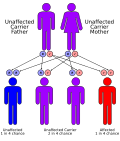Iminoglycinuria: Difference between revisions
CSV import |
CSV import |
||
| Line 33: | Line 33: | ||
{{stub}} | {{stub}} | ||
{{dictionary-stub1}} | {{dictionary-stub1}} | ||
<gallery> | |||
File:Imine.png|Iminoglycinuria | |||
File:Autorecessive.svg|Autosomal recessive inheritance pattern | |||
File:Scheme_sodium-potassium_pump-en.svg|Sodium-potassium pump mechanism | |||
</gallery> | |||
Revision as of 01:51, 18 February 2025
Iminoglycinuria is a rare inherited metabolic disorder characterized by the excessive excretion of certain amino acids in the urine, namely proline, hydroxyproline, and glycine. This condition is generally considered benign, as affected individuals typically do not exhibit any clinical symptoms. Iminoglycinuria is inherited in an autosomal recessive manner.
Causes
Iminoglycinuria is caused by a defect in the renal transport system for imino acids and glycine. This defect results in the excessive excretion of proline, hydroxyproline, and glycine in the urine. The condition is inherited in an autosomal recessive manner, meaning that an individual must inherit two copies of the defective gene, one from each parent, in order to develop the disorder.
Symptoms
Most individuals with iminoglycinuria do not exhibit any clinical symptoms. The condition is typically discovered incidentally during routine urine tests. In rare cases, affected individuals may exhibit mild mental retardation or developmental delay, although it is unclear whether these symptoms are directly related to the disorder.
Diagnosis
Iminoglycinuria is diagnosed based on the results of urine tests that reveal excessive amounts of proline, hydroxyproline, and glycine. Genetic testing may also be performed to confirm the diagnosis and identify the specific gene mutation responsible for the disorder.
Treatment
There is currently no specific treatment for iminoglycinuria. Management of the condition typically involves regular monitoring of amino acid levels in the urine. In rare cases where symptoms are present, treatment is symptomatic and supportive.
See Also
References
<references />






